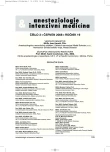Selective bronchial intubation with the UniventR tracheal tube in children
Authors:
Mixa Vladimír 1; Cvachovec Karel 1; Rygl Michal 2; Šnajdauf Jiří 2
Authors‘ workplace:
Klinika anestezie a resuscitace 2. LF UK a FN Motol, Praha
1; Klinika dětské chirurgie 2. LF UK a FN Motol, Praha
2
Published in:
Anest. intenziv. Med., 19, 2008, č. 3, s. 133-137
Category:
Anaesthesiology - Original Paper
Overview
Objective:
Selective bronchial intubation is used to isolate and collapse the treated lung. As a rule, intubation is necessary in order to carry out thoracotomies and thoracoscopies. In adults intubation is carried out using a double-lumen tube. In children whose narrow airways do not allow for the insertion of double - -lumen tubes, we have been using the Univent endotracheal tube with a movable obturator.
Design:
Clinical, retrospective.
Setting:
Department of Anaesthesia and Intensive Care Medicine, University Hospital.
Materials and methods:
A total of 188 patients aged 1.5 to 18 years were included in the study. The children were grouped according to the size of the Univent tube (Fuji System Corp., Tokyo, Japan) inserted. We noted the diagnoses for which the patients were indicated for surgery, and we assessed the difficulties and complications during the insertion and intraoperative use of the Univent tube.
Results:
There were 4 (2.1%) difficult intubations on induction of anaesthesia; 33 cases (17.5%) of difficult insertion of the obturator; and a failure to introduce the obturator in 9 cases (4.8%). Selective intubation of the lungs was unsuccessful in 14 cases (7.4%). The reasons for these complications are analysed in the text.
Conclusions:
Selective intubation of the lungs with the 100% silicone Univent tube is an easy and gentle method suitable for children aged two and up. It is a fully adequate alternative to the double-lumen tube normally used to secure the airway.
Keywords:
paediatric anesthesia – selective intubation – Univent endotracheal tube – biluminal tube – double-lumen tube
Sources
1. Mixa, V., Hechtová, D., Blažek, D. Selektivní intubace a ventilace plic v anestezii dětí. Anest. neodkl. Péče, 1999, 10, p. 249–251.
2. Inoue, H., Shotu, A., Ogawa, J. et al. New device for one lung anesthesia: endotracheal tube with movable blocker. J. Thorac. Cardiovasc. Surg., 1982, 83, p. 940–941.
3. Kayama, H., Krishna, P. R. New endotracheal tube (Univent Tube) for selective blocade of one lung. Anestesiology, 1985, 63, p. 342–343.
4. Inoue, H. Univent endotracheal tube: Twelve-year experience. J. Thorac. Cardiovasc. Surg., 1994, 101, p. 1171–1172.
5. Gayes, M. J. One-lung ventilation is best accomplished with the Univent endotracheal tube. Journal of Cardiothoracic and Vascular Anesthesia, 1993, 7, p. 103–107.
6. Ransom, E., Detterbeck, F., Klein, J. I., Norfleet, E. A. Univent Tube provides a new technique for jet ventilation. Anestesiology, 1996, 84, p. 724–726.
7. Hammer, G. B., Brodsky, J. B., Redpath, J. et al. The Univent tube for single lung ventilation in children. Paed. Anaesth., 1998, 8, p. 55–57.
8. Hammer, G. B., Fitzmaurice, B. G., Brodsky, J. B. Methods for single-lung ventilation in pediatric patiens. Anesth. Analg., 1999, 89, p. 1426–1429.
9. Wagner, D. L., Gammage, G. W., Wong, M. L. Trachea rupture following the insertion of a disposable double-lumen endotracheal tube. Anestesiology, 1985, 63, p. 698–700.
10. Hasan, A., Low, D. E., Ganado, A. L. et al. Trachea rupture with disposable PVC double-lumen tube. J. Cardiothorac. Vasc. Anesth., 1992, 6, p. 208–211.
11. Hammer, G. B., Manos, S. J., Smith, B. M. et al. Single lung ventilation in pediatric patiens. Anestesiology, 1996, 84, p. 1503–1506.
12. Gayes, M. J. Management of Univent bronchial blocking ballon perforation: one-lung ventilation. Anesth. Analg., 1994, 79, p. 1210.
13. Brodsky, J. B., Macario, A., Mark, J. B. D. Tracheal diameter predicts double-lumen tube size: a method for selecting left double lumen tubes. Anesth. Analg., 1996, 82, p. 861–864.
14. Fitzmaurice, B. G., Brodsky, J. B. Airway rupture from double-lumen tubes. J. Cardiothorac. Vasc. Anesth, 1999, 13, p. 322–329.
15. Hanallah, M. S., Benumof, J. L. Comparison of two techniques to inflate the bronchial cuff of the Univent tube. Anesth. Analg., 1992, 75, p. 784–787.
16. Karwadale, S. V. A new tube for single lung ventilation. Chest, 1987, 92, p. 761–763.
17. Hanallah, M. S. The Univent tube: Bronchial cuff inflation. Anestesiology, 1991, 75, p. 165–166.
18. Benumof, J. L. Separation of the two lungs. In Benumof, J. L. Anaesthesia for thoracic surgery. 2nd edition, WB Saunders comp. : Philadelphia 1995, p. 370–379.
19. Fuji System Corp: Univent (promotional brochure). Fuji System Corp, 23-14 Hong 3 Chrome, Bunkyo-Ku, Tokyo, 113 Japan.
20. Ransom, E., Detterbeck, F., Klein, J. I., Norfleet, E. A. Univent tube provides a new technique for jet ventilation. Anestesiology, 1996, 84, 3, p. 724–726.
21. Williams, H., Gothard, J. Jet ventilation via a Univent tube for sleeve pneumectomy. Eur. J. Anaesthesiol., 2001, 18, p. 407–409.
Labels
Anaesthesiology, Resuscitation and Inten Intensive Care MedicineArticle was published in
Anaesthesiology and Intensive Care Medicine

2008 Issue 3
Most read in this issue
- A 39-year patient with a severe haemorrhagic-traumatic shock due to a gunshot, with a left-sided penetrating chest wound resulting in haemothorax, pneumothorax and massive blood loss was treated in the Czech Field Hospital ROLE 2 plus after a terrorist attack in Kabul. The initial Sequential Organ Failure Assessment (SOFA) of 13 points improved thanks to damage control surgery and adequate perioperative care to 5 points, increasing the chance of survival from 5% to 80%. The patient was transported to his homeland on the 3rd postoperative day where he recovered.
- Selective bronchial intubation with the UniventR tracheal tube in children
- Preventive measures of nosocomial infection in ventilated patients – current status
- Research in Anaesthesiology and Resuscitation in the second half of 20th Century
